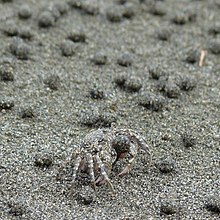| Dotillidae | |
|---|---|
 | |
| Scopimera globosa , a sand bubbler crab | |
| Scientific classification | |
| Domain: | Eukaryota |
| Kingdom: | Animalia |
| Phylum: | Arthropoda |
| Class: | Malacostraca |
| Order: | Decapoda |
| Suborder: | Pleocyemata |
| Infraorder: | Brachyura |
| Section: | Eubrachyura |
| Subsection: | Thoracotremata |
| Superfamily: | Ocypodoidea |
| Family: | Dotillidae Stimpson, 1858 |
The Dotillidae are a family of crabs with 59 species, nearly half of which are in the genus Ilyoplax . [1] The two genera Scopimera and Dotilla are collectively the sand bubbler crabs, which leave conspicuous collections of sand pellets on sandy beaches across the tropical and subtropical Indo-Pacific.